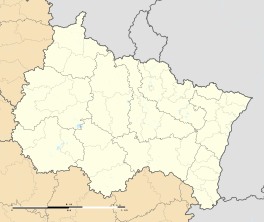Bezonvaux
| Bezonvaux | |
|---|---|
|
| |
 Bezonvaux | |
|
Location within Grand Est region  Bezonvaux | |
| Coordinates: 49°14′15″N 5°28′06″E / 49.2375°N 5.4683°ECoordinates: 49°14′15″N 5°28′06″E / 49.2375°N 5.4683°E | |
| Country | France |
| Region | Grand Est |
| Department | Meuse |
| Arrondissement | Verdun |
| Canton | Charny-sur-Meuse |
| Intercommunality | Charny-sur-Meuse |
| Government | |
| • Mayor (2008–2014) | Jean Laparra |
| Area1 | 9.23 km2 (3.56 sq mi) |
| Population (2012)2 | 0 |
| • Density | 0.0/km2 (0.0/sq mi) |
| Time zone | CET (UTC+1) |
| • Summer (DST) | CEST (UTC+2) |
| INSEE/Postal code | 55050 / 55400 |
| Elevation |
226–367 m (741–1,204 ft) (avg. 257 m or 843 ft) |
|
1 French Land Register data, which excludes lakes, ponds, glaciers > 1 km² (0.386 sq mi or 247 acres) and river estuaries. 2 Population without double counting: residents of multiple communes (e.g., students and military personnel) only counted once. | |
Bezonvaux is a commune in the Meuse department in the Grand Est region in northeastern France.
History
Since the end of the Battle of Verdun in 1916, it has been unoccupied (official population: 0) along with Beaumont-en-Verdunois, Haumont-près-Samogneux, Louvemont-Côte-du-Poivre, Cumières-le-Mort-Homme and Fleury-devant-Douaumont.
-

Historical photo of Bezonvaux
-

State after 9 August 1916
During the war, the town was destroyed and the land was made uninhabitable to such an extent that a decision was made not to rebuild it. The site of the commune is maintained as a testimony to war and is officially designated as a "village that died for France." It is managed by a municipal council of three members appointed by the prefect of the Meuse department.
See also
- Zone rouge (First World War)
- List of French villages destroyed in World War I
- Communes of the Meuse department
References
External links
| Wikimedia Commons has media related to Bezonvaux. |